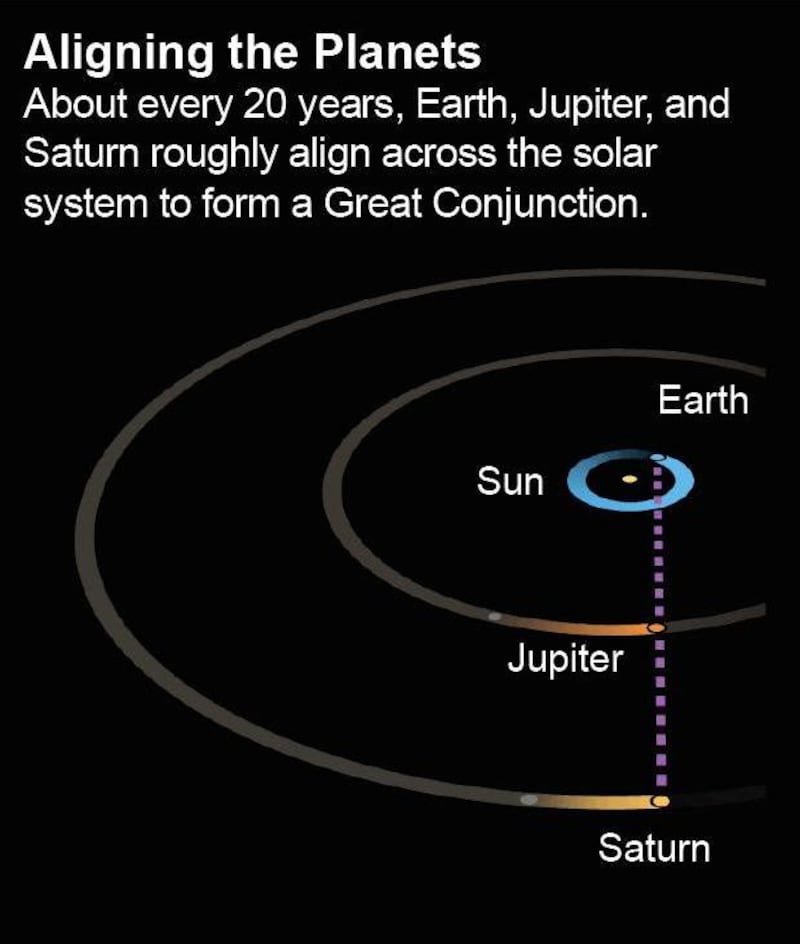A once-in-a-lifetime super conjunction of the two largest planets in the solar system, Jupiter and Saturn, will occur this week with the closest approach expected on Monday afternoon.
This “Christmas star”, or Christmas kiss as it has also been dubbed, will be the closest the two gas giants have appeared in the skies since 1623.
However, that conjunction was not visible in northern latitudes. You would need to go back to 1226 for a comparable conjunction visible in Irish skies.
This forthcoming conjunction will be the two planets’ closest pass this millennium until Christmas day 2874.
US will prioritise post-Brexit trade deal with EU over UK, says congressman
Senior Green Party ministers united in backing EU and Canada trade deal
North’s Covid crisis could repeat in State if situation allowed ‘go out of control’ - Taoiseach
Nearly 300 patients waiting for admission to hospital beds, nurses say
To the naked eye the two gas giants will look like a single star as they make their closest pass on December 21st, the day of the winter solstice, when they will appear just one-fifth of the moon’s diameter away from each other.
Fortunately, the celestial feast of the conjunction will also be available on the days either side of the closest approach, getting lower in the sky as each day passes.
Such a close encounter will not happen again until March 15th, 2080, but that will not be as close as this one.
The conjunctions happen every 20 years or so when the orbits of Jupiter and Saturn are aligned according to our view from Earth.

Viewing advice
Irish Times sky diarist John Flannery recommends watching for the closest approach on Monday evening between 4.45pm and 6.30pm.
He says: “As twilight fades on the evening of the December 21st winter solstice, first look low above the southwestern skyline after 4.45pm with binoculars to spot Jupiter, with Saturn adjacent.
“By 5.30pm the pair are less than a fist-width at arm’s length above the horizon and sinking quickly, but they will be in a darker sky and easier to see with the unaided eye.
“A half hour later sees that altitude halved, and the two planets will likely appear lower if you do not have a unobstructed view towards the southwest. Jupiter and Saturn then exit the evening sky stage at 6.30pm, drawing a final curtain on the drama.”
Harbingers
In the past planetary conjunctions were seen as harbingers of momentous events. A conjunction of Jupiter and Saturn in 1583 was so dreaded that many felt it marked the end of time.
To stem the rising tide of public concern, the then pope issued a bull banning all divinatory practices in 1586.
Our understanding of the nature of the planets began after Italian astronomer Galileo Galilei popularised the use of the telescope in the 1610s.
"Most people tend not to think in such mystical and religious terms nowadays because science cannot measure any influence coming from the planets that can affect us on Earth," said astronomer Dr Stuart Clark, the author of Beneath the Night: How the stars have shaped the history of humankind.
“The great conjunctions are still beautiful to watch, there are perfect opportunities to witness the great forces of the universe moving these planets through their orbits. It’s been thrilling to watch Jupiter and Saturn getting closer and closer together throughout the autumn.
“Above all, events like the great conjunction inspire us to look up at the beautiful night sky and ponder the meaning of it all.”















